Homeopathic medicine has seen a resurgence in popularity in the past few decades. It is common to see homeopathic remedies on the shelves at drug stores, as they are typically over-the-counter treatments that customers can purchase without a prescription.
Homeopathy was commonplace in the United States at the end of the 19th century, after dozens of homeopathic medical schools were founded all across the country beginning in the mid-1800s. Several of these homeopathic colleges were established in St. Louis, the largest of which was the Homeopathic Medical College of Missouri featured in the advertisement below from the 1898 edition of Polk’s Medical and Surgical Register.
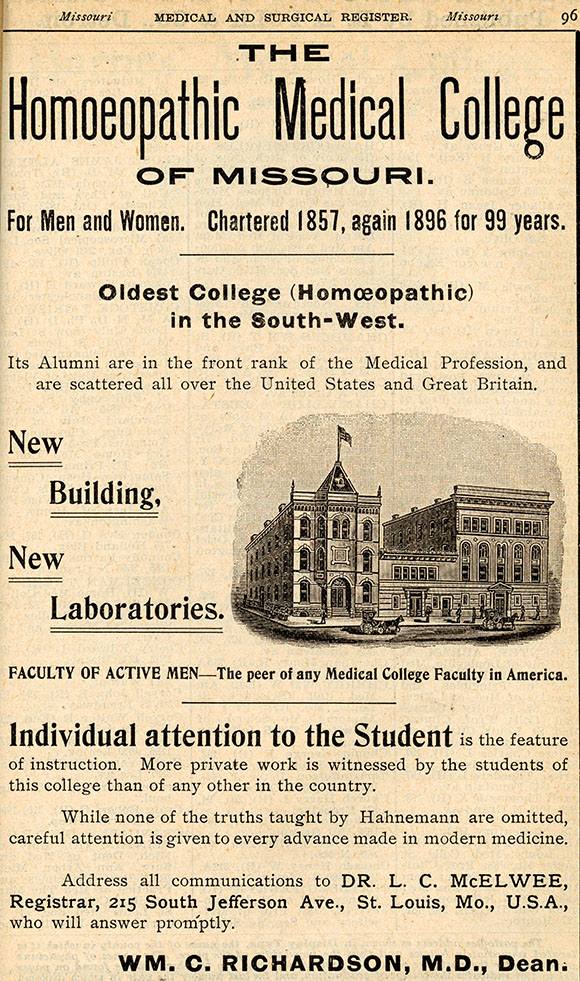
By the late 1800s, there was seemingly an infinite number of homeopathic tonics, pills, and remedies concocted by homeopathic practitioners, who believed that medication should be taken to help the body rejuvenate itself. One of the most popular homeopathic pharmaceutical companies was Humphrey’s Homeopathic Medicine Company, famous for its homeopathy kits that could be sold directly to the public. These kits included dozens of small vials filled with medicinal tablets, and each vial was prominently labeled with a number.
The accompanying Humphreys’ Remedies Index pictured below, provided a list of ailments and the associated medicine number so that users could ensure they took the appropriate medicine to treat the ailment.
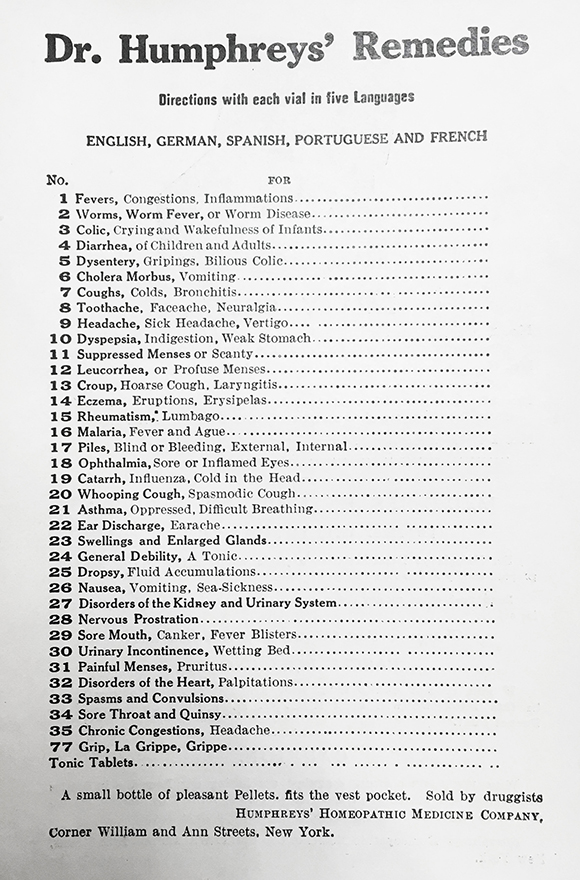
The homeopathic approach to medicine was distinctively different from the more established methodology used in allopathic medicine (also known as “regular” medicine). Homeopathic physicians would often boast – and truthfully so – that they derived their medications from nearly a century of experimentation and methodical research. Commencing in Germany by the founder of homeopathy, Samuel Hahnemann (1755-1843), homeopaths collectively conducted thousands of experiments to build up their list of remedies for various ailments.
The Becker Archives holds a notebook that underscores the experimental nature of homeopathic remedies in the James S. Read Formulary collection. Dr. Read’s notebook contains several homeopathic prescriptions that have been heavily edited and updated, with notations on the effects these medicines have had on patients. A page from this notebook detailing a preparation to treat asthma is below.
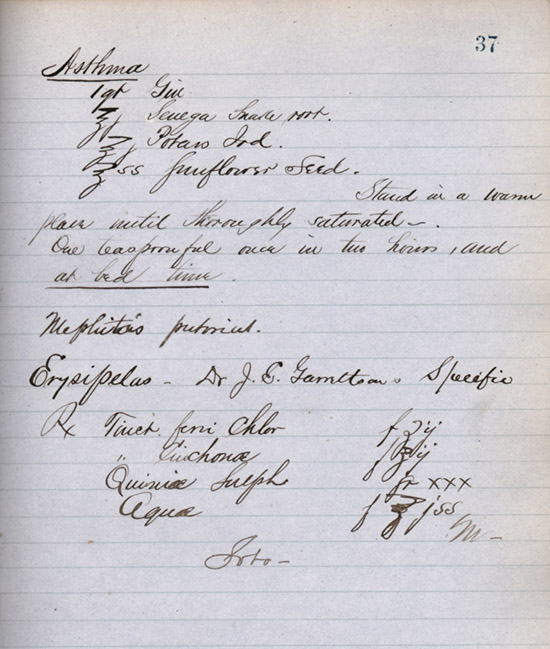
What is particularly interesting about homeopathic research in the 1800s is that their practitioners would regularly test their medicines on healthy people rather than sick people. The focus on healthy individuals was deliberate and falls in line with a core homeopathic concept known as the Law of Similars, or the idea that “like cures like.” Anytime a homeopathic physician would create a new experimental medicine, which were typically plant-based, they would meticulously record how they were formulated.
Homeopaths took careful notes on the source of the plant used, other elements included in the medicine, the amount of each ingredient used, how it was prepared, and how it was administered. When they gave a dose of the experimental medicine to a healthy person, they also took careful notes on what effects it had on that person.
The reason behind the meticulous testing of healthy individuals with new medicines is fascinating because the experiments were designed to induce symptoms that were typically associated with illness. Homeopaths believed if the treatment they created could induce the same symptoms in a healthy person that they are trying to cure in a sick person, they had created a successful remedy because “like cures like.” Becker Library’s rare book collections include a small assortment of catalogs and price lists produced by homeopathic pharmaceutical companies that offered thousands of varieties of such “verified” remedies.
Wise’s Kansas City Homeopathic Pharmacy Company, whose catalog is featured below, specialized in the wholesale of pharmaceutical preparations directly to homeopathic physicians.
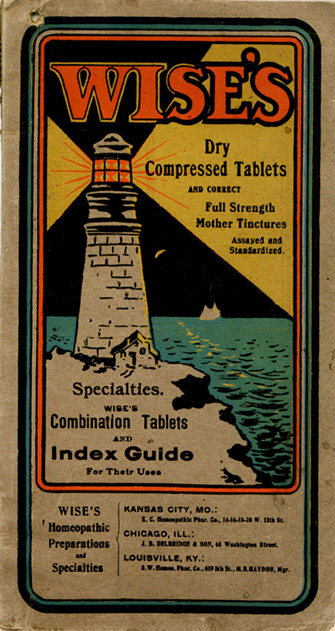
The following example is often used to simplify explaining the concept of “like cures like.” When peeling an onion, the eyes may begin to burn a little or itch for many people. Especially fragrant onions may result in a runny nose and watery eyes. Similarly, those who suffer from seasonal allergies have comparable symptoms to the effects one may have when peeling onions, such as watery eyes and a runny nose. A classic homeopathic remedy to treat allergies is to eat red onions. The effect of eating onions is thought to stimulate the body to rejuvenate itself and relieve the symptoms of allergies because “like cures like.”
Allopathic physicians and homeopathic physicians disagreed, and ferociously so, on the efficacy of such remedies created based on the “like cures like” line of thinking. There were frequent and intense disputes that played out in medical journals between allopathic and homeopathic physicians.
The dissonance carried over into the public realm, as illustrated on the June 13, 1883 front cover of Puck, a popular magazine famous for its political cartoons. In this famous image below, Dr. All O’Path tells a desperate mother that she should not have called a homeopath to treat her child first before calling him.
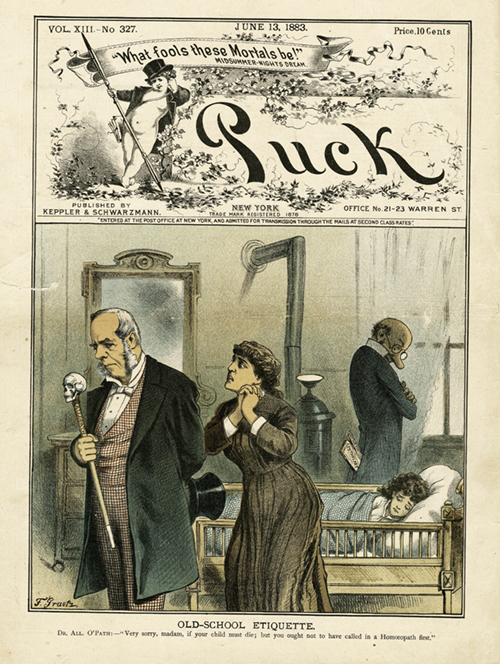
Homeopathy largely fell out of favor with the American public in the early 1900s. As the standards for medical education were elevated at the turn of the century, most homeopathic medical colleges closed. Increasingly rigorous regulations on the sale of pharmaceuticals also contributed to the decline of homeopathy in the U.S.
Still, there remain many followers of homeopathic medicine today. So-called “home remedies” continue to be prevalent today, many of which were derived from homeopathic practices. Supporters of homeopathy value that their medicines are largely derived from naturally occurring substances, compared to the manufactured chemical composition of most prescription pharmaceuticals. This distinction, and the fact that nearly all homeopathic remedies include such diluted amounts of active ingredients, has largely allowed them to be exempt from the regulatory requirements that are otherwise imposed on all other pharmaceutical drugs.
Although not nearly as popular today as it once was, support for homeopathy remains an interesting point of reflection in the science-focused world of medicine.
